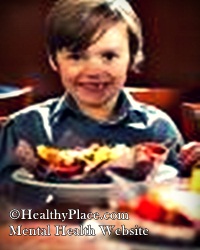Do Narcissists Have Emotions?
Of course they do. All humans have emotions. It is how we choose to relate to our emotions that matters. The narcissist tends to repress them so deeply that, for all practical purposes, they play no conscious role in his life and conduct, though they play an extraordinarily large unconscious role in determining both.
The narcissist's positive emotions come bundled with very negative ones. This is the outcome of frustration and the consequent transformations of aggression. This frustration is connected to the Primary Objects of the narcissist's childhood (parents and caregivers).
Instead of being provided with the unconditional love that he craved, the narcissist was subjected to totally unpredictable and inexplicable bouts of temper, rage, searing sentimentality, envy, prodding, infusion of guilt and other unhealthy parental emotions and behaviour patterns.
The narcissist reacted by retreating to his private world, where he is omnipotent and omniscient and, therefore, immune to such vicious vicissitudes. He stashed his vulnerable True Self in a deep mental cellar - and outwardly presented to the world a False Self.
But bundling is far easier than unbundling. The narcissist is unable to evoke positive feelings without provoking negative ones. Gradually, he becomes phobic: afraid to feel anything, lest it be accompanied by fearsome, guilt inducing, anxiety provoking, out of control emotional complements.
He is thus reduced to experiencing dull stirrings in his soul that he identifies to himself and to others as emotions. Even these are felt only in the presence of someone or something capable of providing the narcissist with his badly needed Narcissistic Supply.
Only when the narcissist is in the overvaluation (idealization) phase of his relationships, does he experience the convulsions that he calls "feelings". These are so transient and fake that they are easily replaced by rage, envy and devaluation. The narcissist really recreates the behaviour patterns of his less than ideal Primary Objects.
Deep inside, the narcissist knows that something is amiss. He does not empathise with other people's feelings. Actually, he holds them in contempt and ridicule. He cannot understand how people are so sentimental, so "irrational" (he identifies being rational with being cool headed and cold blooded).
Often the narcissist believes that other people are "faking it", merely aiming to achieve a goal. He is convinced that their "feelings" are grounded in ulterior, non-emotional, motives. He becomes suspicious, embarrassed, feels compelled to avoid emotion-tinged situations, or, worse, experiences surges of almost uncontrollable aggression in the presence of genuinely expressed sentiments. They remind him how imperfect and poorly equipped he is.
The weaker variety of narcissist tries to emulate and simulate "emotions" - or, at least their expression, the external facet (affect). They mimic and replicate the intricate pantomime that they learn to associate with the existence of feelings. But there are no real emotions there, no emotional correlate.
This is empty affect, devoid of emotion. This being so, the narcissist quickly tires of it, becomes impassive and begins to produce inappropriate affect (e.g., he remains indifferent when grief is the normal reaction). The narcissist subjects his feigned emotions to his cognition. He "decides" that it is appropriate to feel so and so. His "emotions" are invariably the result of analysis, goal setting and planning.
He substitutes "remembering" for "sensing". He relegates his bodily sensations, feelings and emotions to a kind of a memory vault. The short and medium-term memory is exclusively used to store his reactions to his (actual and potential) Narcissistic Supply Sources.
He reacts only to such sources. The narcissist finds it hard to remember or recreate what he ostensibly - though ostentatiously - "felt" (even a short while back) towards a Narcissistic Supply Source once it has ceased to be one. In his attempts to recall his feelings, he draws a mental blank.
It is not that narcissists are incapable of expressing what we would tend to classify as "extreme emotional reactions". They mourn and grieve, rage and smile, excessively "love" and "care". But this is precisely what sets them apart: this rapid movement from one emotional extreme to another and the fact that they never occupy the emotional middle ground.
The narcissist is especially "emotional" when weaned off his drug of Narcissistic Supply. Breaking a habit is always difficult - especially one that defines (and generates) oneself. Getting rid of an addiction is doubly taxing. The narcissist misidentifies these crises with an emotional depth and his self-conviction is so immense, that he mostly succeeds to delude his environment, as well. But a narcissistic crisis (losing a Source of Narcissistic Supply, obtaining an alternative one, moving from one Narcissistic Pathological Space to another) - must never be confused with the real thing, which the narcissist never experiences: emotions.
Many narcissists have "emotional resonance tables". They use words as others use algebraic signs: with meticulousness, with caution, with the precision of the artisan. They sculpt in words the fine tuned reverberations of pain and love and fear. It is the mathematics of emotional grammar, the geometry of the syntax of passions. Devoid of all emotions, narcissists closely monitor people's reactions and adjust their verbal choices accordingly, until their vocabulary resembles that of their listeners. This is as close as narcissists get to empathy.
|
|
To summarise, the emotional life of the narcissist is colourless and eventless, as rigidly blind as his disorder, as dead as he. He does feel rage and hurt and inordinate humiliation, envy and fear. These are very dominant, prevalent and recurrent hues in the canvass of his emotional existence. But there is nothing there except these atavistic gut reactions.
Whatever it is that the narcissist experiences as emotions - he experiences in reaction to slights and injuries, real or imagined. His emotions are all reactive, not active. He feels insulted - he sulks. He feels devalued - he rages. He feels ignored - he pouts. He feels humiliated - he lashes out. He feels threatened - he fears. He feels adored - he basks in glory. He is virulently envious of one and all.
The narcissist can appreciate beauty but in a cerebral, cold and "mathematical" way. Many have no mature, adult sex drive to speak of. Their emotional landscape is dim and grey, as though through a glass darkly.
Many narcissists can intelligently discuss those emotions never experienced by them - like empathy, or love - because they make it a point to read a lot and to communicate with people who claim to be experiencing them. Thus, they gradually construct working hypotheses as to what people feel. As far as the narcissist is concerned, it is pointless to try to really understand emotions - but at least these models he does form allow him to better predict people's behaviours and adjust to them.
Narcissists are not envious of others for having emotions. They disdain feelings and sentimental people because they find them to be weak and vulnerable and they deride human frailties and vulnerabilities. Such derision makes the narcissist feel superior and is probably the ossified remains of a defence mechanism gone awry.
Narcissists are afraid of pain. It is the pebble in their Indra's Net - lift it and the whole net moves. Their pains do not come isolated - they constitute families of anguish, tribes of hurt, whole races of agony. The narcissist cannot experience them separately - only collectively.
Narcissism is an effort to contain the ominous onslaught of stale negative emotions, repressed rage, a child's injuries.
Pathological narcissism is useful - this is why it is so resilient and resistant to change. When it is "invented" by the tormented individual, it enhances his functionality and makes life bearable for him. Because it is so successful, it attains religious dimensions - it become rigid, doctrinaire, automatic and ritualistic.
In other words, pathological narcissism becomes a PATTERN of behaviour. This rigidity is like an outer shell, an exoskeleton. It constrains the narcissist and limits him. It is often prohibitive and inhibitive. As a result, the narcissist is afraid to do certain things. He is injured or humiliated when forced to engage in certain activities. He reacts with rage when the mental edifice underlying his disorder is subjected to scrutiny and criticism - no matter how benign.
Narcissism is ridiculous. Narcissists are pompous, grandiose, repulsive and contradictory. There is a serious mismatch between who they really are, their true accomplishments, and how they regard themselves. The narcissist doesn't merely THINK that he is far superior to others. The perception of his superiority is ingrained in him, it is a part of his every mental cell, an all-pervasive sensation, an instinct and a drive.
He feels that he is entitled to special treatment and to outstanding consideration because he is such a unique specimen. He knows this to be true - the same way one knows that one is surrounded by air. It is an integral part of his identity. More integral to him than his body.
This opens a gap - rather, an abyss - between the narcissist and other humans. Because he considers himself so special and so superior, he has no way of knowing how it is to be human, neither the inclination to explore it. In other words, the narcissist cannot and will not empathise.
Can you empathise with an ant? Empathy implies identity or equality with the empathized, both abhorrent to the narcissist. And being perceived by the narcissist to be so inferior, people are reduced to cartoonish, two-dimensional representations of functions. They become instrumental, or useful, or functional, or entertaining, gratifying or infuriating, frustrating or accommodating objects - rather than loving or emotionally responsive.
It leads to ruthlessness and exploitativeness. Narcissists are not "evil" - actually, the narcissist considers himself to be a good person. Many narcissists help people, professionally, or voluntarily. But narcissists are indifferent. They couldn't care less. They help people because it is a way to secure attention, gratitude, adulation and admiration. And because it is the fastest and surest way to get rid of them and their incessant nagging.
The narcissist may realise these unpleasant truths cognitively - but there is no corresponding emotional reaction (emotional correlate) to this realisation. There is no resonance. It is like reading a boring users' manual pertaining to a computer you do not even own. There is no insight, no assimilation of these truths.
Still, to further insulate himself from the improbable possibility of confronting the gulf between reality and grandiose fantasy (the Grandiosity Gap) - the narcissist comes up with the most elaborate mental structure, replete with mechanisms, levers, switches and flickering alarm lights.
Narcissism Isolates the narcissist from the pain of facing reality and allows him to inhabit the fantasyland of ideal perfection and brilliance.
|
|
APA Reference
Vaknin, S.
(2008, November 16). Do Narcissists Have Emotions?, HealthyPlace. Retrieved
on 2025, December 4 from https://www.healthyplace.com/personality-disorders/malignant-self-love/do-narcissists-have-emotions

 Shortly after the peanut butter incident, I sat down at my computer, cruised some email newsgroups, and discovered a vast and hugely knowledgeable resource: my fellow parents of kids with behavioral disabilities. I quickly learned from these dedicated people that there are nondrug treatments that can make a real difference for children with disorders like Linnea's. It was a vast relief to hear from parents who'd watched their kids fail in school, fail to make friends, even suffer from violent outbursts, and then find some measure of peace.
Shortly after the peanut butter incident, I sat down at my computer, cruised some email newsgroups, and discovered a vast and hugely knowledgeable resource: my fellow parents of kids with behavioral disabilities. I quickly learned from these dedicated people that there are nondrug treatments that can make a real difference for children with disorders like Linnea's. It was a vast relief to hear from parents who'd watched their kids fail in school, fail to make friends, even suffer from violent outbursts, and then find some measure of peace.